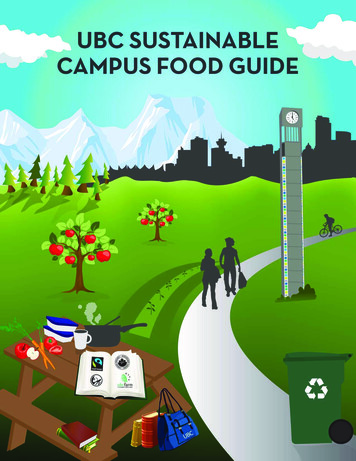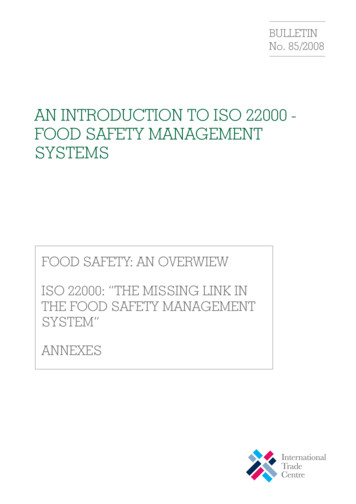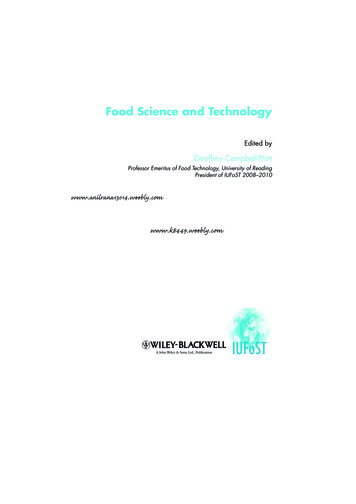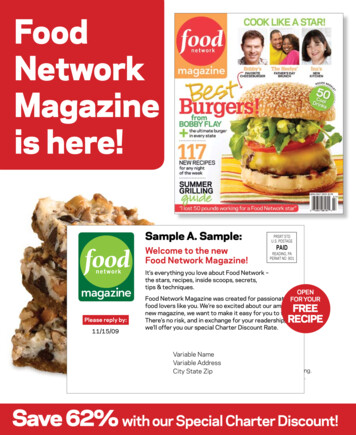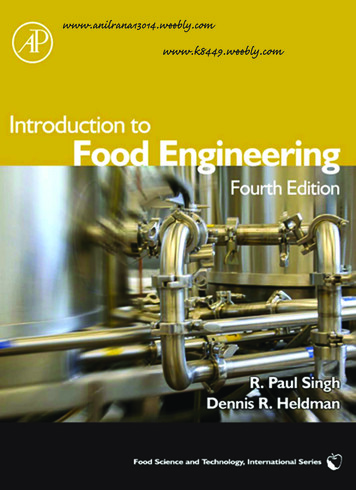
Transcription
www.anilrana13014.weebly.comwww.k8449.weebly.com
Introduction to FoodEngineeringFourth Edition
Food Science and TechnologyInternational SeriesSeries EditorSteve L. TaylorUniversity of Nebraska—Lincoln, USAAdvisory BoardKen BuckleThe University of New South Wales, AustraliaMary Ellen CamireUniversity of Maine, USARoger ClemensUniversity of Southern California, USAHildegarde HeymannUniversity of California—Davis, USARobert HutkinsUniversity of Nebraska—Lincoln, USARon S. JacksonQuebec, CanadaHuub LelieveldBilthoven, The NetherlandsDaryl B. LundUniversity of Wisconsin, USAConnie WeaverPurdue University, USARon WrolstadOregon State University, USAA complete list of books in this series appears at the end of this volume.
Introduction to FoodEngineeringFourth EditionR. Paul SinghDepartment of Biological and Agricultural Engineering andDepartment of Food Science and TechnologyUniversity of CaliforniaDavis, CaliforniaDennis R. HeldmanHeldman AssociatesMason, OhioAMSTERDAM BOSTON HEIDELBERG LONDONNEW YORK OXFORD PARIS SAN DIEGOSAN FRANCISCO SINGAPORE SYDNEY TOKYOAcademic Press is an imprint of Elsevier
Academic Press is an imprint of Elsevier30 Corporate Drive, Suite 400, Burlington, MA 01803, USA525 B Street, Suite 1900, San Diego, California 92101-4495, USA84 Theobald’s Road, London WC1X 8RR, UKCopyright 2009, 2001, 1993, 1984 Elsevier Inc. All rights reserved.No part of this publication may be reproduced or transmitted in any form orby any means, electronic or mechanical, including photocopy, recording, or anyinformation storage and retrieval system, without permission in writing from thepublisher.Permissions may be sought directly from Elsevier’s Science & Technology RightsDepartment in Oxford, UK: phone: ( 44) 1865 843830, fax: ( 44) 1865 853333,E-mail: permissions@elsevier.com. You may also complete your request onlinevia the Elsevier homepage (http://elsevier.com), by selecting “Support & Contact”then “Copyright and Permission” and then “Obtaining Permissions.”Library of Congress Cataloging-in-Publication DataAPPLICATION SUBMITTEDBritish Library Cataloguing-in-Publication DataA catalogue record for this book is available from the British Library.ISBN: 978-0-12-370900-4For information on all Academic Press publicationsvisit our Web site at www.elsevierdirect.comPrinted in China08 09 109 8 7 6 5 4 3 2 1
About the AuthorsR. Paul Singh and Dennis R. Heldman have teamed up here once again, to producethe fourth edition of Introduction to Food Engineering; a book that has had continuing success since its first publication in 1984. Together, Drs. Singh and Heldman havemany years of experience in teaching food engineering courses to students, both undergraduates and graduates; along with Dr. Heldman’s experience in the food processingindustry, is once again apparent in their approach within this book. The authors’ criteria for the careful selection of topics, and the way in which this material is presented,will enable students and faculty to reap the full benefits of this combined wealth ofknowledge.Singh is a distinguished professor of food engineering at the University of California,Davis, where he has been teaching courses on topics in food engineering since 1975.The American Society of Agricultural Engineers (ASAE) awarded him the YoungEducator Award in 1986. The Institute of Food Technologists (IFT) awarded him theSamuel Cate Prescott Award for Research in 1982. In 1988, he received the InternationalAward from the IFT, reserved for a member of the Institute who “has made outstanding efforts to promote the international exchange of ideas in the field of food technology.” In 1997, he received the Distinguished Food Engineering Award from the Dairyand Food Industry Suppliers Association and ASAE, with a citation recognizing himas a “world class scientist and educator with outstanding scholarly distinction andinternational service in food engineering.” In 2007, ASAE awarded him the KishidaInternational Award for his worldwide contributions in food engineering education. Hewas elected a fellow of both IFT and ASAE in 2000 and the International Academy ofFood Science and Technology in 2001. He has helped establish food engineering programs in Portugal, Indonesia, Argentina, and India and has lectured extensively on foodengineering topics in 40 different nations around the world. Singh has authored, orco-authored, fourteen books and published more than two hundred technical papers.His research program at Davis addresses study of heat and mass transfer in foods during processing using mathematical simulations and seeking sustainability in the foodsupply chain. In 2008, Singh was elected to the National Academy of Engineers “forinnovation and leadership in food engineering research and education.” The honor isone of the highest professional distinctions for engineers in the United States.Currently, Heldman is the Principal of Heldman Associates, a consulting businessdedicated to applications of engineering concepts to food processing for educationalinstitutions, industry and government. He is an Adjunct Professor at the University ofCalifornia-Davis and Professor Emeritus at the University of Missouri. His researchinterests focus on use of models to predict thermophysical properties of foods andthe development of simulation models for processes used in food manufacturing.He has been author or co-author of over 150 research papers and is Co-Editor of thev
viAbout the AuthorsHandbook of Food Engineering, and Editor of the Encyclopedia of Agricultural, Foodand Biological Engineering and an Encyclopedia of Biotechnology in Agriculture andFood to be published in 2009. Heldman has taught undergraduate and graduate foodengineering courses at Michigan State University, University of Missouri and Rutgers,The State University of New Jersey. He has held technical administration positions at theCampbell Soup Company, the National Food Processors Association, and the WeinbergConsulting Group, Inc. He has been recognized for contributions, such as the DFISAASAE Food Engineering Award in 1981, the Distinguished Alumni Award from TheOhio State University in 1978, the Young Researcher Award from ASAE in 1974, andserved as President of the Institute of food Technologists (IFT) in 2006–07. In addition,Heldman is Fellow in the IFT (1981), the American Society of Agricultural Engineers(1984), and the International Academy of Food Science & Technology (2006).
ForewordNine out of ten Food Science students would probably claim the Food Engineeringcourse as the most difficult one in their undergraduate curriculum. Although part of thedifficulty may be related to how food engineering is taught, much of the difficulty withfood engineering stems from the nature of the material. It’s not necessarily that foodengineering concepts are more difficult than other food science concepts, but food engineering is based on derivations of equations, and the quantitative manipulation of thoseequations to solve problems.From word problems to integral calculus, the skills required to master food engineering concepts are difficult for many Food Science students. However, these concepts areintegral to the required competencies for an IFT-approved Food Science program, andare the cornerstone for all of food processing and manufacturing. It is critical that FoodScience graduates have a good understanding of engineering principles, both becausethey are likely to need the concepts during the course of their career but also becausethey will most certainly need to interact with engineers in an educated manner. FoodScience graduates who can use quantitative engineering approaches will stand out fromtheir co-workers in the field.Fortunately, two of the leading food engineers, Paul Singh and Dennis Heldman, haveteamed up to write a textbook that clearly and simply presents the complex engineeringmaterial that Food Scientists need to know to be successful. In this fourth edition of aclassic Food Engineering textbook, Singh and Heldman have once again improved thebook even further. New chapters on process control, food packaging, and process operations like filtration, centrifugation and mixing now supplement the classic chapters onmass and energy balances, thermodynamics, heat transfer and fluid flow. Furthermore,numerous problems have now been solved with MATLAB, an engineering mathematicalproblem solver, to enhance student’s math skills.A good textbook should clearly and concisely present material needed by the studentsand at a level appropriate to their backgrounds. With chapters that are broken down intoshort, manageable sections that promote learning, the easy-to-follow explanations inthe 4th Edition of Singh and Heldman are aimed at the perfect level for Food Scientists.Numerous example problems, followed by practice problems, help students test theirunderstanding of the concepts. With fifteen chapters that cover the fundamental aspectsof engineering and their practical application to foods, this book is an ideal text forcourses in both food engineering and food processing. It will also serve as a useful reference for Food Science graduates throughout their career.Richard W. HartelProfessor of Food EngineeringUniversity of Wisconsin-Madisonvii
This page intentionally left blank
PrefaceThe typical curriculum for an undergraduate food science major in the United Statesand Canada requires an understanding of food engineering concepts. The stated content of this portion of the curriculum is “Engineering principles including mass andenergy balances, thermodynamics, fluid flow, and heat and mass transfer”. The expectations include an application of these principles to several areas of food processing.Presenting these concepts to students with limited background in mathematics andengineering science presents a significant challenge. Our goal, in this text book, is toprovide students, planning to become food science professionals, with sufficient background in engineering concepts to be comfortable when communicating with engineering professionals.This text book has been developed specifically for use in undergraduate food engineering courses taken by students pursuing a four-year degree program in food science. Thetopics presented have been selected to illustrate applications of engineering during thehandling, processing, storage, packaging and distribution of food products. Most of thetopics include some descriptive background about a process, fundamental engineeringconcepts and example problems. The approach is intended to assist the student in appreciating the applications of the concepts, while gaining an understanding of problemsolving approaches as well as gaining confidence with the concepts.The scope of the book ranges from basic engineering principles, based on fundamentalphysics, to several applications in food processing. Within the first four chapters, theconcepts of mass and energy balance, thermodynamics, fluid flow and heat transfer areintroduced. A significant addition to this section of the fourth edition is an introduction to the concepts of process control. The next four chapters include applications ofthermodynamics and heat transfer to preservation processes, refrigeration, freezing processes and evaporation processes used in concentration of liquid foods. Following thechapters devoted to the concepts of psychrometrics and mass transfer, several chaptersare used to present applications of these concepts to membrane separation processes,dehydration processes, extrusion processes and packaging. Finally, a new chapter in thisedition is devoted to supplemental processes, including filtration, centrifugation andmixing.Most features of the first three editions of this book are included in this fourth edition.Chapters include modest amounts of descriptive material to assist the student in appreciating the process applications. Although equations are developed from fundamentalconcepts, the equations are used to illustrate the solution to practical problems. Mostchapters contain many example problems to illustrate various concepts and applications, and several examples are presented in spreadsheet program format. At the endof most chapters, lists of problems are provided for the student to use in gaining confidence with problem-solving skills, and the more difficult problems are identified.ix
xPrefaceThe focus of additions to the fourth edition has been on evolving processes and relatedinformation. Chapter 2 has been expanded to include information on properties of dryfood powders and applications during handling of these products. The new material onprocess controls in Chapter 3 will assist students in understanding the systems used tooperate and control food manufacturing operations. Numerous revisions and additions inthe preservation process chapter provide information on applications of evolving technologies for food preservation. Completely new chapters have been included on the subjects ofsupplemental processes (filtration, centrifugation, mixing) and extrusion processes. Finally,a separate chapter has been devoted to food packaging, to emphasize applications of engineering concepts in selection of packaging materials and prediction of product shelf-life.The primary users of this book are the faculty involved in teaching students pursuing anundergraduate degree in Food Science. The approaches used to present the concepts andapplications are based on our own combined teaching experiences. Faculty members areencouraged to select chapters and associated materials to meet the specific objectives ofthe course being taught. The descriptive information, concepts and problems have beenorganized to provide maximum flexibility in teaching. The organization of the information in the book does serve as a study guide for students. Some students may be able tosolve the problems at the end of chapters after independent study of the concepts presented within a given chapter. For the purposes to enhance learning, many illustrationsin the book are available in animated form at www.rpaulsingh.com. This website alsocontains most of the solved examples in an electronic form that allow “what-if” analysis.The topics presented in this book can be easily organized into a two-course sequence. Thefocus of the first course would be on engineering concepts and include information fromChapters 1 through 4, and the second course would focus on applications using Chapters 5to 8. Alternatively, Chapters 9 and 10 could be added to the course on fundamentals, andthe applications from Chapters 11 through 15 would be used in the second course. Thechapters on applications provide an ideal basis for a process-based capstone course.A new feature in this edition is the inclusion of several problems that require the useof MATLAB . We are indebted to Professor Thomas R. Rumsey for generously sharingseveral of these problems that he has used in his own teaching. We thank Ms. BarbaraMeierhenry for her valuable assistance in editing the original manuscript.We appreciate the many recommendations from colleagues, and the encouragementfrom students, as received over a period of nearly 25 years. All of these comments andsuggestions have been valuable, and have made the continuous development of thisbook a rewarding experience. We will continue to respond to communications fromfaculty members and students as the concepts and applications of food engineeringcontinue to evolve.R. Paul SinghDennis R. Heldman
ContentsAbout the Authors . vForeword .viiPreface .ixCHAPTER 1 Introduction . 151.161.171.181.191.201.211.22Dimensions .1Engineering Units .21.2.1 Base Units .21.2.2 Derived Units .31.2.3 Supplementary Units .4System .10State of a System. 111.4.1 Extensive Properties .121.4.2 Intensive Properties .13Density .13Concentration .15Moisture Content .17Temperature.20Pressure .22Enthalpy.26Equation of State and Perfect Gas Law .26Phase Diagram of Water .27Conservation of Mass .291.13.1 Conservation of Mass for an Open System .301.13.2 Conservation of Mass for a Closed System .32Material Balances .32Thermodynamics .41Laws of Thermodynamics .421.16.1 First Law of Thermodynamics .421.16.2 Second Law of Thermodynamics .42Energy .43Energy Balance .45Energy Balance for a Closed System .451.19.1 Heat .451.19.2 Work .46Energy Balance for an Open System .551.20.1 Energy Balance for Steady Flow Systems .56A Total Energy Balance.56Power .59xi
xiiContents1.23 Area .59Problems .60List of Symbols .62Bibliography .63CHAPTER 2 Fluid Flow in Food Processing . 652.1 Liquid Transport Systems .662.1.1 Pipes for Processing Plants .672.1.2 Types of Pumps .682.2 Properties of Liquids . 712.2.1 Terminology Used in Material Response to Stress .722.2.2 Density.722.2.3 Viscosity .732.3 Handling Systems for Newtonian Liquids .812.3.1 The Continuity Equation.812.3.2 Reynolds Number .842.3.3 Entrance Region and Fully Developed Flow.882.3.4 Velocity Profile in a Liquid Flowing Under FullyDeveloped Flow Conditions .902.3.5 Forces Due to Friction.962.4 Force Balance on a Fluid Element Flowing in a Pipe—Derivationof Bernoulli Equation.1002.5 Energy Equation for Steady Flow of Fluids . 1072.5.1 Pressure Energy . 1102.5.2 Kinetic Energy . 1102.5.3 Potential Energy . 1122.5.4 Frictional Energy Loss . 1122.5.5 Power Requirements of a Pump . 1152.6 Pump Selection and Performance Evaluation . 1192.6.1 Centrifugal Pumps . 1192.6.2 Head .1212.6.3 Pump Performance Characteristics .1212.6.4 Pump Characteristic Diagram . 1252.6.5 Net Positive Suction Head . 1262.6.6 Selecting a Pump for a Liquid Transport System . 1292.6.7 Affinity Laws . 1352.7 Flow Measurement . 1362.7.1 The Pitot Tube . 1402.7.2 The Orifice Meter . 1422.7.3 The Venturi Meter. 1462.7.4 Variable-Area Meters . 1462.7.5 Other Measurement Methods . 147
Contents xiiiMeasurement of Viscosity . 1482.8.1 Capillary Tube Viscometer . 1482.8.2 Rotational Viscometer . 1502.8.3 Influence of Temperature on Viscosity . 1532.9 Flow Characteristics of Non-Newtonian Fluids . 1552.9.1 Properties of Non-Newtonian Fluids . 1552.9.2 Velocity Profile of a Power Law Fluid .1612.9.3 Volumetric Flow Rate of a Power Law Fluid . 1622.9.4 Average Velocity in a Power Law Fluid. 1632.9.5 Friction Factor and Generalized Reynolds Numberfor Power Law Fluids . 1632.9.6 Computation of Pumping Requirement ofNon-newtonian Liquids . 1662.10 Transport of solid foods . 1692.10.1 Properties of Granular Materials and Powders .1702.10.2 Flow of Granular Foods . 175Problems . 178List of Symbols . 183Bibliography . 1852.8CHAPTER 3 Energy and Controls in Food Processes . 1873.13.23.33.43.5Generation of Steam . 1873.1.1 Steam Generation Systems . 1883.1.2 Thermodynamics of Phase Change . 1903.1.3 Steam Tables . 1943.1.4 Steam Utilization . 200Fuel Utilization . 2043.2.1 Systems . 2063.2.2 Mass and Energy Balance Analysis .2073.2.3 Burner Efficiencies .209Electric Power Utilization . 2103.3.1 Electrical Terms and Units .2123.3.2 Ohm’s Law .2133.3.3 Electric Circuits .2143.3.4 Electric Motors .2163.3.5 Electrical Controls.2173.3.6 Electric Lighting .218Process Controls in Food Processing . 2203.4.1 Processing Variables and Performance Indicators. 2223.4.2 Input and Output Signals to Control Processes . 2243.4.3 Design of a Control System. 224Sensors . 232
xivContents3.5.1 Temperature . 2323.5.2 Liquid Level in a Tank. 2343.5.3 Pressure Sensors . 2353.5.4 Flow Sensors. 2363.5.5 Glossary of Terms Important in Data Acquisition . 2373.6 Dynamic Response Characteristics of Sensors . 237Problems .241List of Symbols . 244Bibliography . 245CHAPTER 4 Heat Transfer in Food Processing . 2474.1 Systems for Heating and Cooling Food Products . 2484.1.1 Plate Heat Exchanger . 2484.1.2 Tubular Heat Exchanger . 2524.1.3 Scraped-surface Heat Exchanger. 2534.1.4 Steam-infusion Heat Exchanger . 2554.1.5 Epilogue. 2564.2 Thermal Properties of Foods . 2574.2.1 Specific Heat . 2574.2.2 Thermal Conductivity . 2604.2.3 Thermal Diffusivity . 2624.3 Modes of Heat Transfer . 2644.3.1 Conductive Heat Transfer . 2644.3.2 Convective Heat Transfer . 2674.3.3 Radiation Heat Transfer . 2694.4 Steady-State Heat Transfer.2704.4.1 Conductive Heat Transfer in a Rectangular Slab .2714.4.2 Conductive Heat Transfer through a Tubular Pipe . 2744.4.3 Heat Conduction in Multilayered Systems . 2774.4.4 Estimation of Convective Heat-Transfer Coefficient . 2854.4.5 Estimation of Overall Heat-Transfer Coefficient .3024.4.6
the fourth edition of Introduction to Food Engineering; a book that has had continu-ing success since its fi rst publication in 1984. Together, Drs. Singh and Heldman have many years of experience in teaching food engineering courses to students, both under-graduates and graduates; a



